It has been said—and I believe this to be true—that we live in a tabletop gaming renaissance. It started two decades ago around the release of The Settlers of Catan (1995), and the number of high-quality games released increases with every passing year. Game designers continue to excel at their craft; they provide us with minimal, elegant systems and intricate, beautiful machines that challenge our thoughts and actions. A sense of discovery and wonder pervades this design space, inspiring players of competitive and cooperative games alike. I see it in the eyes of the people I play these games with, and it’s the closest we’ve gotten to the intangible and ineffable notion of fun in ages.
This year was filled with designs that exhibit hybrid forms and genres, ranging from abstract cooperation to historical conflict to empire- and economy-building and much more. Having played many (but not all!) of these mutations, I have made an attempt to present only ten… my 11-20 list would make a worthy list as well. What a year. (I barely worked a day.)
10. Eight Minute Empire
Designed by Ryan Laukat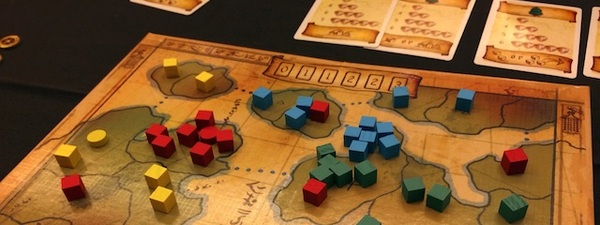
Creating an “epic” empire building experience in less than an hour is somewhat of a holy grail among game designers. Laukat has achieved this goal in, well, twenty minutes of play. With one simple action per turn, each player collects sets of resources and expands their presence on a small, fictional map. It amazes me that a game this small provides so many avenues to victory. It’s a game that asks to be played over and over again.
9. Terra Mystica
Designed by Jens Drögemüller and Helge Ostertag
In videogame design circles, many say that it’s impossible to separate presentation from the overall game experience. The Terra Mystica box is full of beautiful components—and more wooden pieces than the deluxe version of Settlers—but it helps that the game doesn’t suck, either: area control and expansion, combined with terraforming (each of the playable races requires a different terrain type), provides strategic choice with respect to the placement and upgrading of one’s dwellings. It also contains cults and mages to, you know, terraform. This is complex, deep colony-building at its best.
8. Forbidden Desert
Designed by Matt Leacock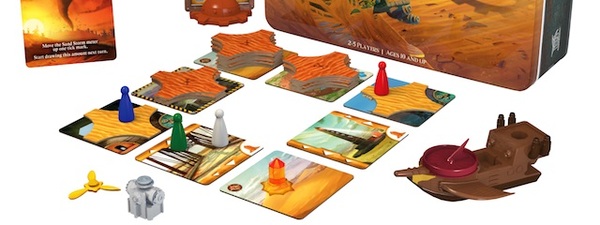
From the creator of the popular Pandemic (2008) and Forbidden Island (2010) comes another great cooperative game. Unlike Forbidden Island, which, while great, is sort of a Pandemic-lite, Forbidden Desert creates fresh uncertainty by introducing players to the nightmare of being buried by a sandstorm. To avoid said burial, and thus a premature end to the session, players excavate tiles on the board to unearth a flying machine (in four separate parts, of course) with which they can escape their sandy graves and win. Adding insult to injury, the storm can move the machine parts from where they were originally found and bury them in sand. What, you don’t think this sounds like fun?
7. Nations
Designed by Rustan Håkansson, Nina Håkansson, Einar Rosén, and Robert Rosén
This civilization building game was a big hit at the 2013 SPIEL in Essen, Germany, the world’s largest tabletop game fair. Inspired by Through the Ages (TtA, 2006), Agricola (2007), and some other contemporary games, the designers have created a worker placement, nation-building game that rivals Chvatil’s TtA in scope and feel. In a genius move, and in typical Euro-style, the designers omit targeted interaction while still encouraging ongoing rivalries—forget to invest in military strength, and your carefully constructed nation of scholars and intellectuals will soon be a thing of the past. According to the designer diary on boardgamegeek.com, Nations was five years in the making. Good things take time and skill and craft and iteration.
6. Quantum
Designed by Eric Zimmerman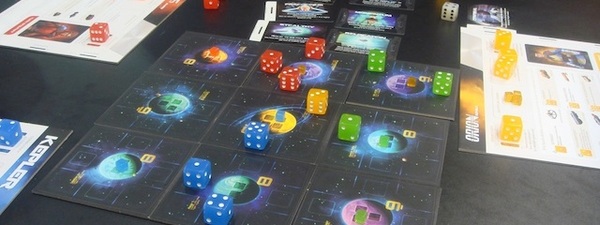
In Quantum, dice are space ships on a modular board. Not sold yet? Okay then, let me elaborate: In Quantum, dice (yes, DICE!) are space ships moving around, attacking enemies and constructing the quantum cubes needed to win. The number on each die not only relates to its attack/defense (lower is better) and how far it can move but also provides the player with a special ability on each turn. Add card-based research powers into the mix, and what we have is Mr. Zimmerman’s version of space chess with some very carefully designed randomness. Take a bow, Eric. (Full disclosure: Eric and I are fellow Brooklyners, colleagues at NYU and friends.)
5. Amerigo
Designed by Stefan Feld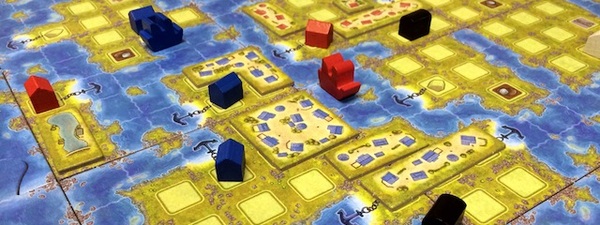
Amerigo is a 3X game (exploration, expansion and exploitation) played on a modular board representing a South American island atoll. Players move ships, establish trading posts, plan and build villages, and produce/multiply goods using a randomization contraption known as a cube tower. You feed a set of colored cubes through the tower, but some get stuck inside and may fall out on future turns. This seemingly minor modification that influences which actions can be taken on a given turn introduces a tension that breaks analysis paralysis (over-thinking the current game state). Did I mention that players need guns to avoid being attacked and looted by pirates? Without sufficient guns, the pirates steal a non-trivial amount of victory points. Victory points! Stupid pirates.
4. Ascension: Rise of Vigil
Designed by Justin Gary
Rise of Vigil is the fourth Ascension expansion in the ongoing deckbuilding series. Gary outdid himself by adding a new resource, energy shards and a mechanic by which these are acquired and used: Energy shards are added under the available center row cards when these are drawn from the central deck, thus making some central row cards more valuable for players. This alters the standard selection dynamic significantly. Ascension is a game for people who love Dominion (2008) and are not turned off by a fantasy theme, though I’d recommend starting with earlier versions of the game before graduating to the current pinnacle of the form, Rise of Vigil. Much of the series’s popularity comes from an iOS version that contains the base game, three expansions, and promo cards. Get on it.
3. Bruges
Designed by Stefan Feld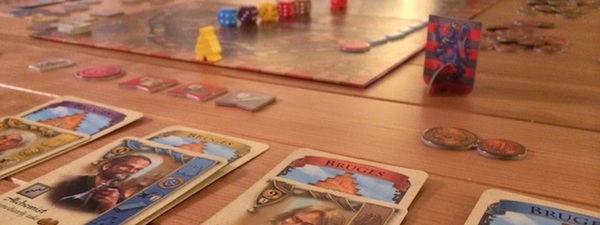
On first sight, one may mistake Bruges for a boardgame. Instead, it’s an absolutely wonderful card game with a minor boardgame component. At its heart, Bruges is about hard choices, much like the glorious Race for the Galaxy (2007). Each card in your hand allows for only one of 6 (!) different actions, and the power and effect of these actions is influenced by the color of the card as well as the corresponding die rolled at the beginning of each turn. One action allows playing the card as a permanent effect, thereby adding to one’s tableau and prosperity, but only if one has previously built a house (yes, this also requires using up a card). This game provides the most interesting use of cards I have seen to date.
2. Francis Drake
Designed by Peter Hawes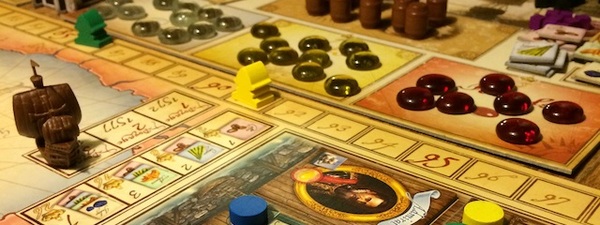
My view of this game is heavily influenced by the fact that my game-loathing dad enjoyed playing this with me on Christmas Day (yes, I was reviewing for this article until 12/26). Players prepare to sail to the Caribbean, where they attack Spanish villages, forts and galleons. But they also need to trade goods for valuable commodities. In the preparation phase, the game combines worker placement/action selection with bidding along a road similar to Tokaido (2012), where a player can select a better action before all other players at the cost of potentially skipping many possible actions. The outcome of the preparation phase influences the success of the following expedition, wherein players secretly select the order in which they wish to execute on their plans. The game is rich with theme and a slew of perfectly combined game mechanics, all wrapped inside the best production values I’ve seen this year. Just get it.
1. Hanabi
Designed by Antoine Bauza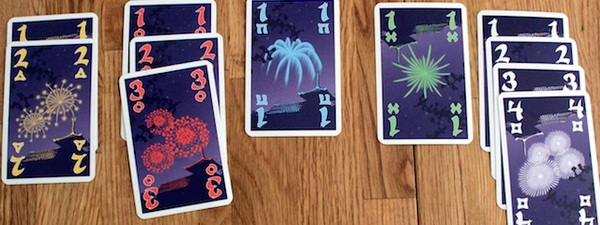
Hanabi is this year’s winner of the prestigious Spiel des Jahres (SdJ) award, and I have to say that I agree with the jury. Players cooperate to share information in order to complete sets of 5 numbered cards (numbered 1-5), in five different colors, in ascending order. But cards are held backwards, such that a player can see all cards except their own. Only other players can provide information about one’s hand… through color or numbers, but never both in one turn. Achieving the perfect score of 25 seems impossible, and I’ve only ever reached 22 (or simply lost). As a proponent of minimalism, elegance and abstraction—and knowing firsthand how hard it is to design such a game—I tip my hat to Bauza. It’s a short game that goes for under ten bucks. If you’re still reading this article, you should most definitely be playing this game.
And that’s that. I’m sure Uwe Rosenberg’s Caverna, a follow-up to Agricola (2007), would have made the list, but I was not able to obtain a copy, and I have yet to play other games that look amazing, such as Level 7 [Omega Protocol], Space Cadets: Dice Duel and Carnival Zombie. But these will need to wait until 2014! These are the year’s other games that I did play, which didn’t quite make the list (in order): Russian Railroads, Bora Bora, 1775 Rebellion, Keyflower, Mascarade, Castaways, Kemet, Pathfinder Adventure Card Game, Dungeons of Mandom, Suburbia, and Glass Road. And I still play and love Netrunner—it’s only gotten better in 2013.
It was a good year for board and card games. Maybe, next year, I just won’t play any videogames at all. Maybe I’ll become one of those guys who start working on an all-time favorite tabletop games list. Maybe.
Andy Nealen is a game designer and an assistant professor of Computer Science at NYU Poly. Follow him on Twitter at @nealen.